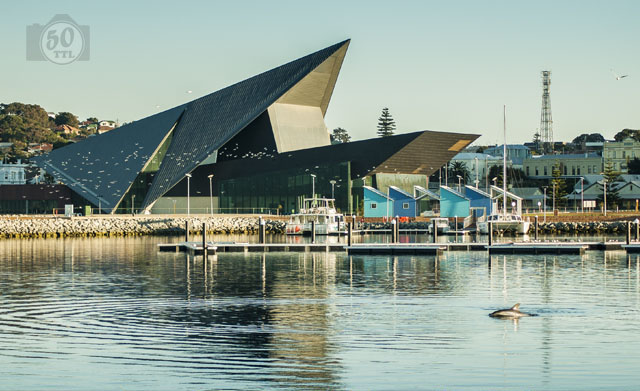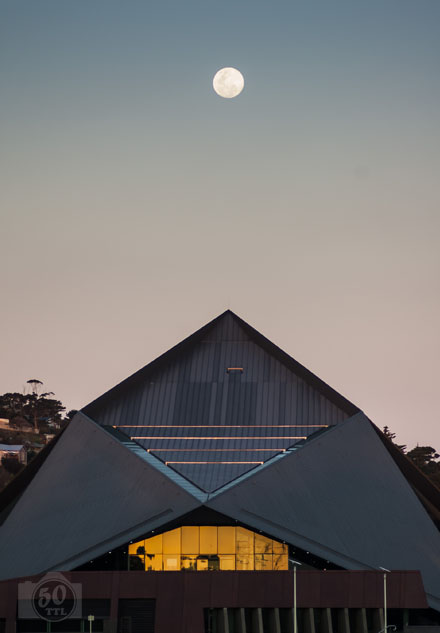
At the end of 2010, the Albany Entertainment Centre opened, providing a focal point for photos at the town’s waterfront. From 2011, I found myself drawn back to the waterfront time after time, just to explore the possibilities of this striking piece of architecture.
Early in 2011, I was lucky enough to spot a couple of dolphins casually cruising through the marina, and caught this photo as one of them surfaced. You would not get this photo today, because the marina is now full of boats. At this stage, all the pens were empty as the marina awaited its official commissioning.
On another visit to the waterfront later in the year, I explored a different angle to the entertainment centre. I like the symmetry of the photo below, with the building’s sloping roofline pointing to the full moon. The centre’s western windows reflect the sunset glow and provide a balancing highlight in the lower third of the photo.

But the photo was taken on the D50, and I wanted to work with higher resolution images. I kept reading about new model full-frame cameras to be released by Nikon. Then it started raining in Thailand, and there was terrible flooding that claimed many lives and had a serious economic impact. Nikon’s factory in Thailand was severely affected by floodwaters, and plans for new models were set back. My first world problem was a speck of dust compared to the consequences for the Thai people, but the outcome was that I decided to upgrade to the D700 rather than wait any longer.

On one of my first outings with the new camera, I took this photo at the local markets. As soon as I opened it on the computer, I felt satisfied with my purchase. The colours were deeper, richer and truer than the colours from the earlier camera. Even now, and a model further on, I often experience a fundamental sense of satisfaction at the depth and subtlety of the colours when I open a full-frame photo.
As mentioned in the 2010 post, phone cameras were on the rise. They have improved vastly over the past decade. However, the image quality is unlikely ever to equal the image quality from a full-frame camera. More glass gathers more light and delivers more subtle tonal qualities in the final image. A phone camera’s tiny lens and sensor will always be working with less information than a full-size lens and sensor.
Many of the advances in phone camera image quality are due to improvements in the processing software, not only advances in the lenses and sensors. I assume that many of those software improvements rely on data gathered from the many free photo processing apps, enabling phone camera app developers to learn how people want a particular sort of photo to look.
I don’t want group-think enhancements made for me. But whatever image enhancing tools become available to phone apps will also be available to photos from other sources, and when the other source is a full-frame camera, the tools can then be applied to a base image that is better to start with.